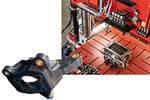Sigma Engineering adds compression molding simulation to Sigmasoft Virtual Molding
In addition to a reworked user interface, the full process simulation software now includes the ability to view all thermal influences on the component and in the mold.
The view of the mold when opening (left) when closing (right). Thermal influences in the mold seen from the outside. Photo Credit: Sigma Engineering GmbH
(Aachen, Germany) presents the evolution of Sigmasoft Virtual Molding, a full process simulation software designed to overcome the challenges associated with development, mold design and production in injection molding. The new version 6.0 is said to have a fresh user interface and, beside other new features, now also contains the possibility to analyze compression molding of elastomers.
Until now, simulative mold and process design were limited mainly to modern injection molding technology, the company says. However, the desire to simulate other processes, such as compression and transfer molding was voiced by several customers, since they are often used to manufacture precision parts.
With the introduction of simulative compression molding, Sigmasoft enables users to zoom into the production process in every location, anytime and in any cycle. Examples include the thermal influence of the open mold, during preparation and while preforms are positioned — or to analyze plastification and curing of the elastomer, or other advanced materials, in detail. The simulation also enables a secure evaluation of curing degree and process-cycle data, according to Sigma Engineering. Issues such as the quantity, shape, weight and position of the preforms can also be optimized easily, ultimately improving the quality of the molded parts while reducing material use.
According to Sigma CTO, Timo Gebauer, the implementation was complex, the challenge primarily stemming from the cavity, which constantly changes during the closing of the mold. At the same time, the inserted preforms are already heating up, and are plasticizing and deforming. Gebauer adds that this development would not have passed the finish line without continuous advice and validation through its customers.
Related Content
-
Combining multifunctional thermoplastic composites, additive manufacturing for next-gen airframe structures
The DOMMINIO project combines AFP with 3D printed gyroid cores, embedded SHM sensors and smart materials for induction-driven disassembly of parts at end of life.
-
Bladder-assisted compression molding derivative produces complex, autoclave-quality automotive parts
HP Composites’ AirPower technology enables high-rate CFRP roof production with 50% energy savings for the Maserati MC20.
-
Low-cost, efficient CFRP anisogrid lattice structures
CIRA uses patented parallel winding, dry fiber, silicone tooling and resin infusion to cut labor for lightweight, heavily loaded space applications.



